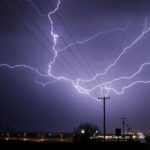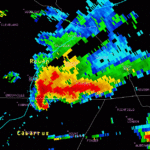The strong winds and lightning produced by thunderstorm activity is a major cause of electrical power outages across the United States during the warm season. Strong winds (including straight-line gusts, microburst outflows, and tornadoes) often down trees and tree limbs which can affect power transmission and distribution lines. Lightning strikes can also negatively impact the distribution infrastructure (e.g., transformers, power-line poles). Thus, restoring electrical power in a timely manner involves, not only positioning sufficient repair crews at critical locations within the distribution grid, but also accurately anticipating the location and severity of such significant weather events. From both the weather forecasting and outage response perspectives, one particularly challenging scenario is when severe storms are not well forecast, yet storms develop and produce numerous power outages. Such events require meteorologists to anticipate outage densities in near real-time, while prolonging the outages because repair crews could not be pre-positioned. In contrast, another challenging scenario is when significant thunderstorm activity is well-forecast and numerous repair crews are pre-positioned, but the storms do not produce widespread outages. Such events require a better ability to distinguish outage-producing storms, and their environments, from non-outage-producing storms.
This project was aimed toward minimizing power outage duration by using a combination of radar, lightning, and environmental parameters derived from numerical model analyses, land-use / land-cover, soil moisture, population, and power infrastructure databases to develop spatiotemporal models that predicted power outages across multiple services areas.
This research was funded by a generous grant from Duke Energy.
Relevant Publications and Presentations:
Eastin, M. D., 2020: Thunderstorm-induced power outages: Final Report. Duke Energy Tech Memo, 201 pages. (Not available to the public)
Eastin, M. D., 2020: Predicting the spatiotemporal distribution of thunderstorm-induced power outages. 11th Conference on Weather Climate and the New Energy Economy, Boston, MA, American Meteorological Society
Eastin, M. D., and R. Cucinotta, 2019: Diagnosing and predicting thunderstorm-induced power outages. 10th Conference on Weather Climate and the New Energy Economy, Phoenix, AZ, American Meteorological Society

